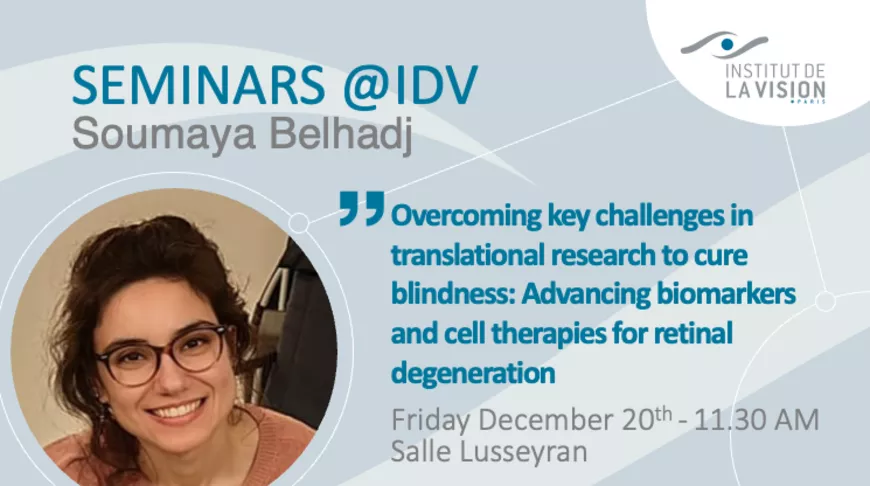Advancing Biomarkers and Cell Therapies for Retinal Degeneration
Invited by Serge Picaud, Soumaya Belhadj (postdoc in Juliette McGregor's Lab at the University of Rochester-New York, USA) will speak on Friday december 20th - 11.30 AM, salle Lusseyran.

Abstract
Inherited retinal dystrophies (IRDs), such as retinitis pigmentosa or cone dystrophies, are a diverse group of genetic diseases characterized by photoreceptor dysfunction and potentially cell death. IRDs are currently still untreatable and eventually may lead to blindness. Consequently, several therapeutic strategies have been devised in order to ameliorate the course of these disorders. A key challenge in therapy development is the lack of clinical biomarkers for a thorough assessment of treatment efficacy.
In this talk, I will present the work conducted during my PhD and postdoctoral studies addressing these two major challenges.
In my PhD thesis, the knowledge on the cell death mechanisms was used to find targets and to develop assays that may be used in vivo non-invasively to quantify and temporally monitor cell death. Two assays assessing PARP and calpain proteases activity were developed. An assay using a substrate for calpain proteases was found to be better suited to detect calpain activity in living tissue. This newly established assay was used to investigate cell death mechanisms and the role of calpains in photoreceptor degeneration.
My postdoctoral work is focusing on the development of photoreceptor replacement therapy. Cell therapies are at a relatively early stage of development but have the potential to restore high quality vision. Optimizing these therapies at the pre-clinical stage in an animal model that closely resembles the human is key to successful translation to the clinic. Adaptive Optics Ophthalmoscopy provides an innovative preclinical development platform for evaluating the success of vision restoration therapies in non-human primates allowing structural and functional assessment of outcomes at the cellular scale in the living eye. I will describe recent progress on stem cell-derived photoreceptor replacement therapies delivered as bioengineered tissue scaffolds or as suspensions in a fibrinogen vehicle in the non-human primate, including structural signs of photoreceptor precursor survival, maturation and connectivity.
About Soumaya Belhadj
Soumaya received her MSc degree in Neuroscience from the Université Pierre et Marie Curie in Paris after completing her Master Thesis in Zurich. After her graduation, she performed a 6-month postgraduate internship in Basel at the Novartis Institutes for Biomedical Research in the Department of Autoimmunity, Transplantation and Inflammation. She then started her PhD thesis, entitled 'Toward the development of new biomarkers for retinal degeneration', within the transMed consortium in Prof. François Paquet-Durand's Lab (University of Tübingen, Germany). After her PhD graduation, Soumaya performed a short postdoc in Prof. Mathias Seeliger's Lab (University of Tübingen) where she learned electroretinography. Since March 2023, she is a postdoc in Juliette McGregor's Lab at the University of Rochester (New York, USA) and works on photoreceptor replacement therapy and adaptive optics retinal imaging.
